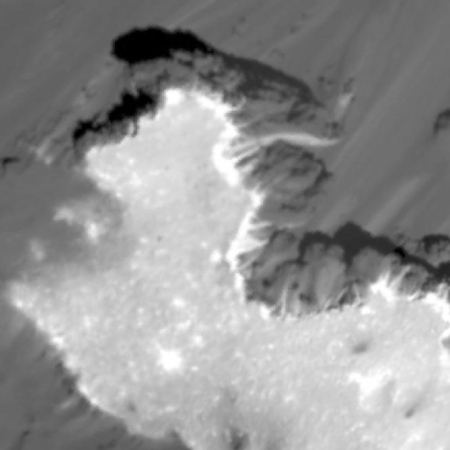Close look at bright spots in Occator Crater on Ceres
Cool image time! In this week’s release of new images from Dawn, the science released close-ups of one of the bright spots located on the floor of Occator Crater on Ceres. The image on the right, cropped and reduced in resolution to post here, shows one white-topped mesa in that crater.
The geometry of this feature is similar to a mesa or large butte with a flat top. It has been puzzling scientists since its discovery in the early images of the Dawn mission at Ceres. These new images reveal many details. In particular, the relationships between the bright material, mostly composed of sodium carbonate, and the dark background might hold clues about the origin of the facula.
If you click on the image you can see the full image at full resolution.
The sun appears to be coming from the southeast, with the mesa’s cliff’s at the top. Along with some scattered bright spots, the white material appears to have a bright area aligned along the cliff’s rim. The white material also appears to be flowing down one gully in that cliff face.
It is important to remember that these bright spots are generally found in a depression in the crater. scientists now think they are remnants of a volcano-like mound that after erupting slowly slumped back down. Note also that the soft puffiness of the cliff faces probably indicates the lower density of this material due to Ceres’s tiny gravity, about 3% that of Earth’s.
On Christmas Eve 1968 three Americans became the first humans to visit another world. What they did to celebrate was unexpected and profound, and will be remembered throughout all human history. Genesis: the Story of Apollo 8, Robert Zimmerman's classic history of humanity's first journey to another world, tells that story, and it is now available as both an ebook and an audiobook, both with a foreword by Valerie Anders and a new introduction by Robert Zimmerman.
The print edition can be purchased at Amazon or from any other book seller. If you want an autographed copy the price is $60 for the hardback and $45 for the paperback, plus $8 shipping for each. Go here for purchasing details. The ebook is available everywhere for $5.99 (before discount) at amazon, or direct from my ebook publisher, ebookit. If you buy it from ebookit you don't support the big tech companies and the author gets a bigger cut much sooner.
The audiobook is also available at all these vendors, and is also free with a 30-day trial membership to Audible.
"Not simply about one mission, [Genesis] is also the history of America's quest for the moon... Zimmerman has done a masterful job of tying disparate events together into a solid account of one of America's greatest human triumphs."--San Antonio Express-News
Cool image time! In this week’s release of new images from Dawn, the science released close-ups of one of the bright spots located on the floor of Occator Crater on Ceres. The image on the right, cropped and reduced in resolution to post here, shows one white-topped mesa in that crater.
The geometry of this feature is similar to a mesa or large butte with a flat top. It has been puzzling scientists since its discovery in the early images of the Dawn mission at Ceres. These new images reveal many details. In particular, the relationships between the bright material, mostly composed of sodium carbonate, and the dark background might hold clues about the origin of the facula.
If you click on the image you can see the full image at full resolution.
The sun appears to be coming from the southeast, with the mesa’s cliff’s at the top. Along with some scattered bright spots, the white material appears to have a bright area aligned along the cliff’s rim. The white material also appears to be flowing down one gully in that cliff face.
It is important to remember that these bright spots are generally found in a depression in the crater. scientists now think they are remnants of a volcano-like mound that after erupting slowly slumped back down. Note also that the soft puffiness of the cliff faces probably indicates the lower density of this material due to Ceres’s tiny gravity, about 3% that of Earth’s.
On Christmas Eve 1968 three Americans became the first humans to visit another world. What they did to celebrate was unexpected and profound, and will be remembered throughout all human history. Genesis: the Story of Apollo 8, Robert Zimmerman's classic history of humanity's first journey to another world, tells that story, and it is now available as both an ebook and an audiobook, both with a foreword by Valerie Anders and a new introduction by Robert Zimmerman.
The print edition can be purchased at Amazon or from any other book seller. If you want an autographed copy the price is $60 for the hardback and $45 for the paperback, plus $8 shipping for each. Go here for purchasing details. The ebook is available everywhere for $5.99 (before discount) at amazon, or direct from my ebook publisher, ebookit. If you buy it from ebookit you don't support the big tech companies and the author gets a bigger cut much sooner.
The audiobook is also available at all these vendors, and is also free with a 30-day trial membership to Audible.
"Not simply about one mission, [Genesis] is also the history of America's quest for the moon... Zimmerman has done a masterful job of tying disparate events together into a solid account of one of America's greatest human triumphs."--San Antonio Express-News



How do scientists know “bright material, mostly composed of sodium carbonate” from a picture???
Guessing, from the spectrum of light received by the camera aboard the probe.
Edward: They know the composition not from this picture but from other spectroscopic data taken by other instruments.
Looks like foam sealant to prevent too much atmosphere loss :-)